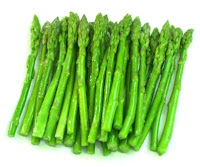Milk and Cream
- Fresh milk
- Whole milk is fresh milk with nothing removed and nothing (except vitamin D) added
- Contains 3.5% fat, 8.5% nonfat milk solids, 88% water
- It available in several forms:
- Pasteurized milk - been heated to kill disease-producing bacteria, then cooled
- Raw milk - not been pasteurized
- Certified milk - produce by disease-free herds under very strict sanitary conditions
- Homogenized milk - been processed so that cream doesn't separate out
- Skim or nonfat milk - most of fat removed (0.5% less fat)
- Low-fat milk - fat content of 0.5 to 3%
- Fortified nonfat or low-fat milk - added substances to increase nutritional value
- Flavored milks - added flavoring ingredients
- Cream
- Whipping cream - fat content of 30% to 40%
- Light cream - fat content of 16% to 22%
- Half and half - fat content of 10% to 12%
- Creme fraiche - a slightly aged, cultured heavy cream
- Fermented Milk
- Sour cream - fermented by added lactic acid bacteria
- Buttermilk - cultured by bacteria
- Yogurt - custard, has additional milk solids, flavored and sweetened added
- Milk Product with Water Removed
- Evaporated milk - sterilized milk, 60% water removed
- Condensed milk - whole milk, 60% water removed, heavily sweetened with sugar
- Dried whole milk - whole or skim milk, dried to powder
Milk and Cream - Cooking
- Problems in cooking milk and cream products:
- Curdling - milk proteins solidify and separate from thewey
- Scorching - milks coagulates on the bottom of the pan
- Skin formation - formation of scum or skin on top of heated milk
- Whipping cream - 1 liter of cream produces up to 2 liters of whipped cream
- Steps in whipping cream
- have cream and all equipment well chilled
- do not sweeten until the cream is whipped
- do not overwhip
- cream to be folded into other ingredients should be underbeaten
Butter
- Characteristics and Grades
- fresh butter consists of about 80% milk fat
- most butter on the market is lightly salted
- sweet, unsalted butter is more perishable but has a fresher, sweeter taste
- butter is the preferred cooking fat
- clarified butter is used as a cooking fat most often than whole butter
- the smoke point for butterfat is only 127 C to 130 C
- should be kept well wrapped at 2 C
Margarine
- made from various vegetable and animal fats, plus flavoring ingredients, emulsifiers, coloring agents, preservatives, and added vitamins
- 80 % fat
- handled and stored like butter
Cheese
- food produced by separating milk solids from whey by curdling or coagulation.
- components of cheese:
- water - 80% (fresh soft cheese), 30% (very hard, aged cheese)
- fat - refer to the percentage of solids
- protein
- Ripening
- process that converts freshly made curds into distinctive, flavorful cheeses
- classified by the kind of ripening agent
- bacteria ripened, from inside - Cheddar, Swiss, Gouda, Parmesan
- bacteria ripened, from outside - Limburger, Liederkranz
- mold ripened, from inside - Blue cheeses
- mold ripened, from outside - Brie, Camembert, St Andre
- unripened - Cottage, Cream, bakers cheese
Cream Cheese
Feta Cheese
Mascarpone Cheese
Mozarella Cheese
Ricotta Cheese
- Semisoft Cheeses
- Bland and buttery when young to more earthy and full flavored when older
Bel Paese Cheese
Muenster Cheese
Pont I' Eveque
Port Salut
St Andre Cheese
- Hard Ripened Cheeses
- Curd cheeses with a firmtexture and varying degrees of mildness or sharpness, depending on their age
Emmenthaler Cheese
Cheddar Cheese
Edam Cheese
Gouda Cheese
Gruyere Cheese
- Blue-Veined Cheeses
- owe their flavor and appearance to the blue or green mould that mottles their interiors
Roquefort Cheese
Gorgonzola Cheese
Picon Cheese
Stilton Cheese
- Goat Cheese
- made from goat's milk, called Chevre.
Chabis Cheese
Boucheron Cheese
Banon Cheese
- Hard Grating Cheeses
- Typified by Italian parmesan, called grana cheeses.
Romano Cheese
Mimolette Cheese
Parmigiano Reggiano Cheese
- Process Cheeses
- made by grinding one or more natural cheeses, heating and blending them with emulsifiers and other ingredients, and pouring the mixture into molds to solidify.
- usually mild in flavor and gummy intexture
- Cheese - Storage and Service
- Storing
- the firmer and more aged the cheese, the longer it will keep
- soft ripened cheeses deteriorate rapidly once they reach maturity
- other ripened cheeses are not fussy, store them under refrigeration and well wrapped to prevent drying
- Serving
- serve cheese at room temperature
- cut cheese just before service to prevent drying
- better yet, set outwhole and cut to order
- Cheese - Cooking with Cheese
- Guidelines for cooking with cheese
- cheddar is used in dishes like sauces, casserole, melted or gratineed topping
- swiss-type cheeses are often used in European dishes. Emmanthaler and Gruyere are essential ingredients for fondue, mornay sauce, gratineed dishes, souffles and quiches
- parmesan-type cheeses are used in grated form for toppings and seasoning
- many other varieties are called for in specialized recipes
- use short cooking times
- grate cheese for faster and more uniform melting
- aged cheeses melt and blend into foods more easily than young cheese
- aged cheese adds more flavor to foods than young, mild cheeses, so you need less of it.











































































